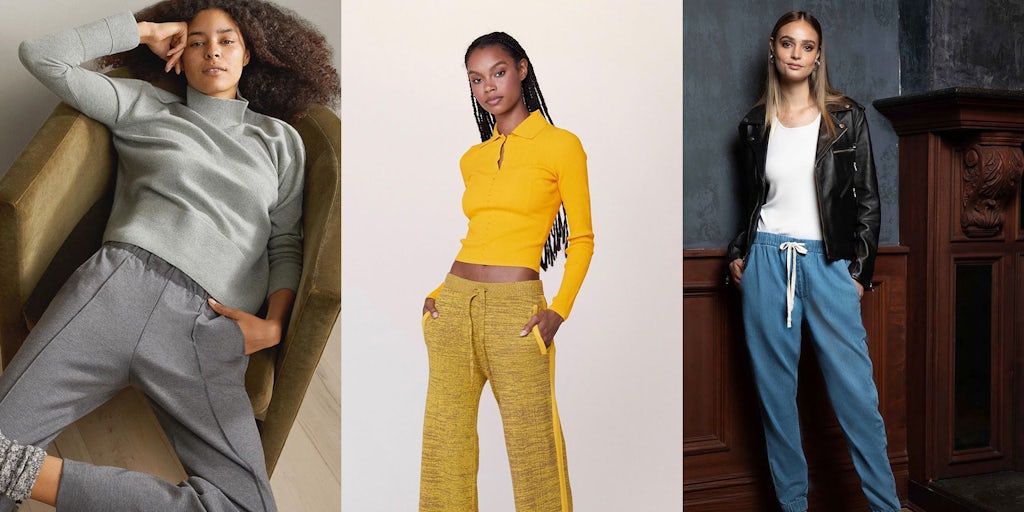What Comes After Sweatpants | Intelligence, BoF Professional
NEW YORK, United States – Consumers the world over have swaddled themselves in leggings and athleisure since March. Fashion brands are itching for them to move on.
Brands that profited from the comfy clothing boom at the start of the pandemic know there are only so many pairs of sweats they can sell. But rather than pivot right back to suits and button-down tops, many labels are easing customers back to fitted clothing.
Take denim: jeans took a big hit during the first wave of lockdowns, when homebound shoppers saw little point to encasing their legs in itchy, constricting fabric. Now, brands are attempting to revive the category, with some key modifications. The number of new denim styles featuring elastic waistbands jumped 35 percent between September and October, according to Edited, a retail analytics firm.
Elastic waists are a sign that comfort-first fashion isn’t going anywhere, even as consumers work, dine and shop outside their homes again. Stretchy fabrics also make for a smoother e-commerce operation as online sales boom – fewer sizes and forgiving waists eliminate fit issues and reduce returns.
“To stay competitive, it will be more important than ever for brands to design into comfortable fabrics, closures and details across products,” said Avery Faigen, a retail analyst at Edited.
Just Add Polyester
Shein, an online fast-fashion retailer popular with teens, increased its selection of jeans with stretchy fabrics by 263 percent between February and June, in every style from ripped to skinny. Free People, 7 For All Mankind and Joe’s are also among the denim brands that have released versions of the flexible waist pant for non-maternity shoppers.
“The elastic [or] flexible waistband is an easy way to ensure it works for all body types and can enhance the curves with a touch of street style,” said Molly Miao, Singapore-based chief marketing officer and co-founder of Shein. “This will be an ongoing trend and will be adapted into other design silhouettes.”
Contemporary brands offer bottoms in polished fabrications such as lightweight wool and cotton poplin – complete with elastic waistbands for added comfort, said Matt Feniger, director of TOBETDG by The Doneger Group, a New York fashion merchandising and consulting group.
Pre-pandemic, stretch and elastic was already creeping into many items already. While Cinq à Sept just started offering the new styles, Margaret Howell had already tiptoed into relaxed cuts, pleated jeans with elastic subtly sewn into the waistbands and roomy overalls.
Some companies are redesigning their garments to fit the current relaxation craze, adding a drawstring with the elasticised waist. But many simply blend up to 15 percent of synthetic material, such as polyester, spandex or elastane, into an existing design to soften the fabric. American Eagle’s Ne(x)t Level jeggings are seven percent polyester and one percent elastane, for instance.
Sustainable brands are turning to cottonised hemp, Tencel and other biodegradable fabrics. It’s not just jeans, either: Moss Bros. sells wool-blend “supreme stretch suits,” which are made of 39 percent polyester and two percent elastane.
Stretching Demand
Whether any of these hybrid clothes will sell is an open question. France, Germany and some US cities have reimposed strict lockdowns amid a new wave of coronavirus cases. Some experts say life may not begin to return to normal until deep into 2021, even if a vaccine is released soon. Consumers may have plenty more months of lounging at home ahead.
And even when they do head outside again, tastes could just as easily snap back to pre-Covid times, with sweats and elastic-waisted pants seen as a reminder of the pandemic. For now, however, comfort matters most.
A McKinsey & Company study found that 54 percent of shoppers in August believe practicality and comfort are very important decision factors when it comes to buying clothing (up from 32 percent in April). Fashion and style are only important to 28 percent of shoppers (a significant drop since pre-Covid), the study found, up nine percent since April.
Still, Covid restrictions have begun to ebb and flow, and with those, shoppers have started to dress up their loungewear to leave the house. To capture this market, retailers are repositioning stretchy clothing so customers see them as an upgrade from what they’ve been wearing at home, rather than a downgrade from what they wore pre-pandemic.
Brands are pairing their new elastic offerings with more structured, high-end items, says Erica Russo, a fashion consultant and former fashion director at Bloomingdale’s.
“Whether it’s a cute high-waisted elastic-back jean or faux leather sweatpants, the options are more fabulous than frumpy,” she said.
A.L.C. just launched an activewear collaboration with Bandier, styling snake print leggings with a blazer from the collection that was made from a technical fabric. It’s not far from the popular bike shorts and blazer look that began appearing late this summer and fall, Russo said.
Adding elements like drawstrings that make clothing more comfortable but don’t scream “sweatpants” is also important. Live the Process, for one, sells a line of drawstring knit pants, while Everlane has “The Dream Pant,” which includes an elastic pull-on waist and has a sweatpant feel but is tailored enough to wear with a sweater or blazer. The brand advertises it with a tailored coat.
In the past month, shoppers at wear-to-work label Ameliora have been slowly gravitating toward clothing that is comfortable, yet slightly dressier than leggings, said Adrienne Kronovet, the brand’s founder and chief executive.
Kronovet said her cargo pant and her slim leg pants — which are made out of four-way stretchy, breathable material and have a two-inch waistband — are now selling at nearly twice the rate of $175 leggings. She’s been able to convert her customers to the new looks via styling suggestions provided in direct emails and social media. Kronovet said she markets the cargo pants as the chic, but comfortable, leggings alternative.
“They feel like leggings, but look more formal,” Kronovet said. “You’re starting to see a rise of versatile clothing that can be worn both inside and outside.”
The Right Fit
While consumers may have grown weary of wearing their sweats daily, there’s another sneaky reason why fashion has pivoted: most fitting rooms are closed due to the pandemic.
Leggings and sweats may be easy to fit since most are offered in small, medium or large. Shoppers may be reluctant to purchase anything more restrictive without trying it on first and retailers may be wary of all the free returns, said personal fashion stylist Soneca Guadara.
So nearly all the denim brands have not only started incorporating stretch waistbands but also added stretch fibres into the fabric after years of pushing 100 percent cotton styles, said Patrick Kenger, men’s personal stylist with Pivot Image Consulting.
“It marries the best of both worlds and allows people to look great and feel comfortable,” Kenger said.
The push toward stretch appears to be a win-win, especially right now, when most people are shopping for their clothing online. Free shipping and returns have become a major problem for brands, though products that use stretch materials lead to a decreased exchange and return rate, said Lee Johnson, founder of Old Bull Lee, a clothing company based in California.
“Society’s acceptance of casual wear, the move to online sales and the issue that we presently do not have any accurate way to guarantee fit…means that garments made from materials that have a degree of sizing forgiveness are the reality of where we are until some other changes happen in the formula,” Johnson said.
Related Articles:
Now That Everyone Has Sweatpants, What Else Do They Want to Buy?
Sweatsuits and Yoga Pants Are Selling Like Crazy. What Happens When Lockdowns End?
‘Athleisure’ Trend Booms As Sweatpants Leave the Gym





